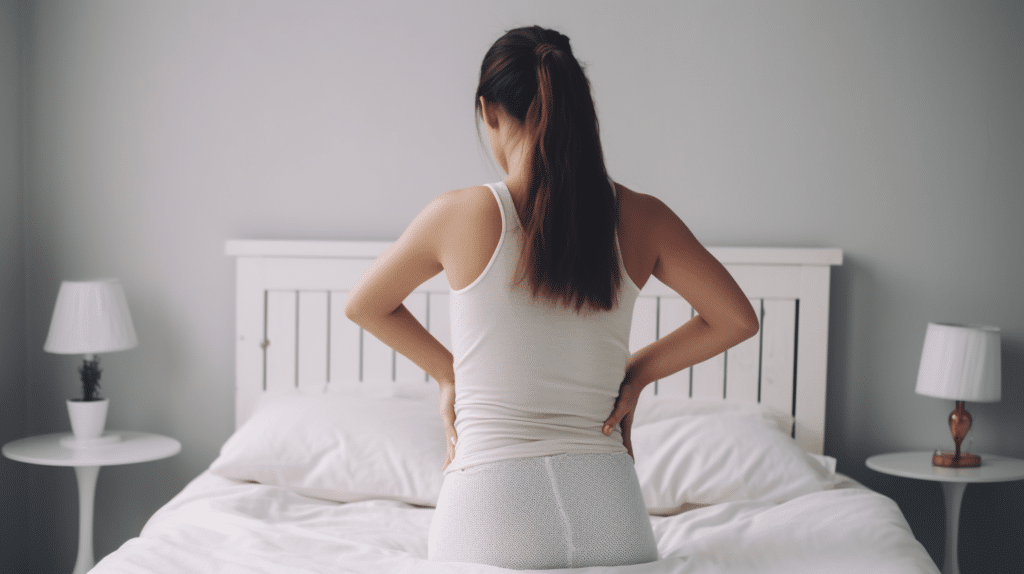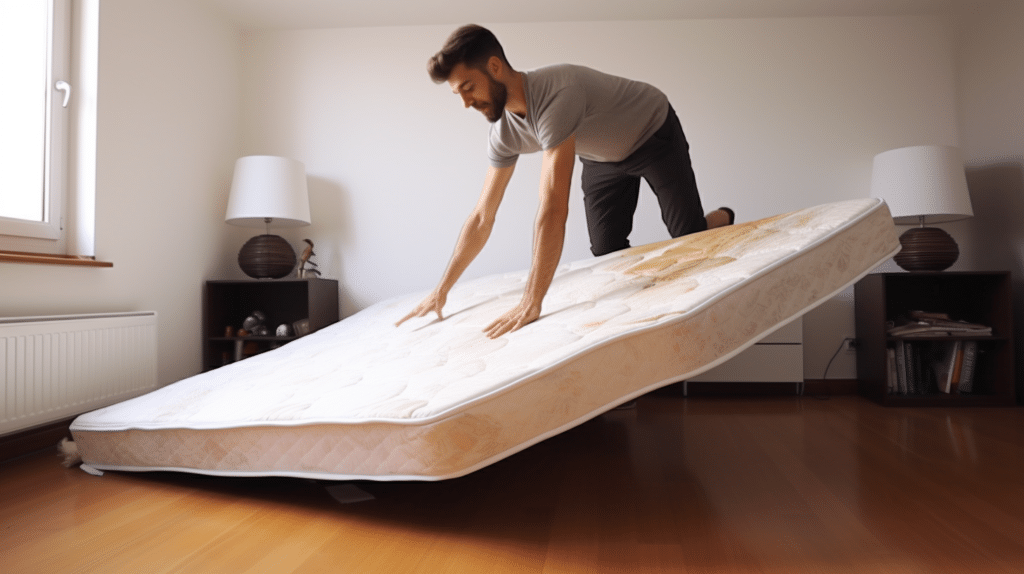Do you often wake up with a nagging back pain that just won’t go away? Have you considered that your mattress might be the culprit behind this discomfort? It may come as a surprise, but your choice of mattress can indeed play a significant role in causing or alleviating back pain. In this article, we will delve into the connection between mattresses and back pain, helping you understand how your sleeping surface can impact your spinal health.
Getting a good night’s sleep is crucial for overall well-being, and having the right mattress is key to achieving that. When it comes to back pain, the type of mattress you sleep on can either exacerbate or alleviate your symptoms. Different mattresses offer varying levels of support and comfort, which directly affects how well your spine is aligned during sleep. By understanding the link between mattresses and back pain, you can make an informed decision when choosing the best one for yourself. So let’s dive in and explore how finding the right mattress can help banish those morning pains!
The Importance of a Good Night’s Sleep
Get ready for a game-changing revelation: a good night’s sleep is absolutely crucial for your overall well-being! You may not realize it, but the quality of your sleep has a direct impact on your physical and mental health. Poor sleep can lead to a range of negative effects on your overall health, including increased risk of chronic conditions like heart disease, obesity, and diabetes. Not only that, but sleep deprivation can also have a significant impact on your productivity levels throughout the day. When you don’t get enough restful sleep, you’re more likely to feel fatigued, have difficulty concentrating, and experience decreased cognitive function. So if you’re waking up with back pain or feeling unrested in the morning, it’s worth considering whether your mattress could be playing a role in disrupting your sleep quality and affecting your overall well-being.
Understanding the Link Between Mattresses and Back Pain

Understanding how your sleeping surface can impact your body’s comfort and well-being is crucial when it comes to alleviating discomfort. The choice of mattress materials and the age of your mattress can have a significant impact on back pain. Different materials provide different levels of support and pressure relief, so it’s essential to choose one that suits your specific needs. Additionally, as mattresses age, they tend to lose their ability to provide adequate support, leading to increased pressure on certain areas of your body, including the spine. This can result in back pain and discomfort throughout the night. Therefore, regularly assessing the condition of your mattress and considering its age is essential for maintaining proper spinal alignment and reducing the risk of back pain caused by an unsupportive sleeping surface.
Types of Mattresses and Their Impact on Back Health
Choosing the right type of mattress can make a world of difference in how your body feels and functions, leading to improved comfort and well-being. When it comes to material selection for mattresses and back pain, there are a few key factors to consider. Memory foam mattresses are often recommended for individuals with back pain as they provide excellent support and contouring to the body’s natural curves. These mattresses help alleviate pressure points, allowing for better spinal alignment during sleep. On the other hand, innerspring mattresses may not offer the same level of support and can contribute to discomfort or exacerbate existing back pain. Additionally, it is important to note that mattress age also plays a significant role in back health. Over time, mattresses tend to lose their firmness and supportiveness, which can lead to increased pressure on the spine and muscles. It is generally recommended to replace your mattress every 7-10 years or when you start experiencing noticeable sagging or discomfort. By carefully selecting a mattress with appropriate materials and keeping track of its age, you can ensure optimal back health and reduce the risk of developing or worsening back pain.
Finding the Right Mattress for Your Body Type
Lying on a mattress that perfectly conforms to your body’s unique shape can greatly enhance your comfort and sleep quality. When it comes to finding the right mattress for side sleepers, memory foam mattresses offer numerous benefits. The contouring properties of memory foam allow it to mold to the curves of your body, providing optimal support and pressure relief. This is especially beneficial for side sleepers who often experience pressure points in their shoulders and hips. Memory foam also helps align the spine properly, promoting better spinal alignment and reducing the risk of waking up with back pain. So, if you’re a side sleeper looking for a mattress that will provide both comfort and support, consider investing in a memory foam option tailored to your body type.
Firmness Levels and Spinal Alignment
When it comes to finding the perfect mattress, getting the right firmness level is crucial for ensuring proper spinal alignment and a restful night’s sleep. Everyone has different firmness preferences, so it’s important to find a mattress that suits your individual needs. Some people may prefer a firmer mattress for extra support, while others may find a softer mattress more comfortable. It’s also worth considering the materials of the mattress as they can affect its firmness level. Memory foam mattresses tend to offer a medium-firm feel and contour to your body shape, providing excellent spinal alignment. On the other hand, innerspring mattresses are generally firmer and provide more bounce. Ultimately, finding the right balance between firmness and spinal alignment is key to preventing back pain and promoting better sleep quality.
The Role of Pillow Support in Reducing Back Pain
To alleviate discomfort and promote proper spinal alignment, it’s essential to prioritize adequate pillow support. When it comes to reducing back pain, your choice of pillow can play a crucial role. Different sleep positions require different levels of support and cushioning. For example, if you sleep on your back, a medium-firm pillow that supports the natural curve of your neck while keeping your head in line with your spine is ideal. On the other hand, if you’re a side sleeper, using a slightly higher and firmer pillow can help maintain proper alignment by filling in the space between your ear and shoulder. For those who prefer sleeping on their stomachs, a softer and flatter pillow is recommended to prevent excessive strain on the neck. By selecting the right pillow based on your preferred sleep position, you can effectively reduce back pain caused by improper spinal alignment during sleep.
Considerations for Individuals with Specific Back Conditions
Now that you understand the importance of pillow support in reducing back pain, let’s delve into considerations for individuals with specific back conditions. If you have a specific back condition, such as a herniated disc or sciatica, it is crucial to choose an appropriate mattress that provides proper support and alignment for your spine. An ergonomic office chair can also play a significant role in alleviating back pain while sitting for long periods. Additionally, incorporating physical therapy exercises into your daily routine can help strengthen the muscles that support your back and improve overall spinal health. By addressing these factors, you can ensure that your mattress and lifestyle choices are working together to minimize back pain and promote a healthy spine.
Signs That Your Mattress May be Contributing to Back Pain
If you’re waking up feeling sore and uncomfortable, it’s time to pay attention to the telltale signs that your bed could be contributing to your morning misery. One important factor to consider is finding the right mattress for side sleepers. Side sleeping is a common position that can put strain on the lower back if the mattress does not provide adequate support. Look for a mattress that contours to your body’s curves while still maintaining proper alignment of your spine. Another consideration is the role of mattress toppers in alleviating back pain. Mattress toppers can provide an extra layer of cushioning and support, helping to relieve pressure points and reduce discomfort. Choose a topper with materials that promote spinal alignment, such as memory foam or latex. By paying attention to these factors and making sure your mattress and toppings are suitable for your needs, you can find relief from back pain caused by an unsupportive bed.
Tips for Maintaining a Healthy Sleep Environment
Creating a sleep environment conducive to optimal rest and well-being involves factors such as keeping the room cool, using blackout curtains, and investing in high-quality bedding. However, one crucial aspect that often gets overlooked is maintaining proper sleep posture and having a supportive mattress. When it comes to back pain, a mattress that doesn’t provide adequate support can be a major culprit. A good quality mattress will distribute your body weight evenly and help align your spine properly while you sleep. This can alleviate pressure points and reduce strain on your back muscles. So, if you’re experiencing back pain or want to prevent it altogether, investing in a supportive mattress can have significant benefits for your overall sleep health.
Seeking Professional Advice for Chronic Back Pain
When it comes to dealing with persistent discomfort in your back, seeking professional advice can provide valuable insights and potential solutions. If you are experiencing chronic back pain, it is important to consult with a healthcare professional who specializes in musculoskeletal issues or spinal conditions. They have the expertise and knowledge to properly diagnose the underlying cause of your pain and recommend appropriate treatment options. Whether it’s physical therapy, chiropractic care, medication, or surgery, seeking professional advice can help you find long-term relief from your chronic back pain. Don’t hesitate to reach out for help – there are professionals who are dedicated to helping individuals like you find the best solutions for their unique situations.
Conclusion
In conclusion, it is important to recognize that your mattress can indeed be a contributing factor to back pain. By understanding the link between mattresses and back health, you can make informed decisions when choosing the right mattress for your body type. Considering factors such as firmness levels and spinal alignment will help ensure that your mattress provides proper support to alleviate or prevent back pain.
Furthermore, individuals with specific back conditions should take extra care in selecting a mattress that caters to their needs. It is crucial to be aware of the signs that indicate your current mattress may be causing or exacerbating back pain. By maintaining a healthy sleep environment and seeking professional advice for chronic back pain, you can take steps towards improving both the quality of your sleep and the health of your back. Remember, investing in a high-quality mattress suited to your individual needs can go a long way in promoting overall well-being and reducing discomfort.

